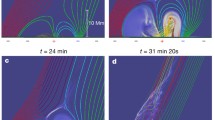Abstract
Recent observations of Martin, Bilimoria, and Tracadas (1995) have revealed two new magnetic and structural classes for solar filaments and filament channels. The magnetic classes are called sinistral and dextral, while the structural classes are left-bearing and right-bearing. Dextral filaments dominate in the northern hemisphere and sinistral in the southern. A model consistent with the observations is developed with magnetic sources that represent the network flux on both sides of the channel and extra concentrations of flux that produce the strong field component along the channel. We suggest that it is the imbalance of flux locations along the channel that creates the field of a filament channel. The resulting separatrix surfaces have distinct upper and lower boundaries that may produce the upper boundary of the filament cavity or filament and the lower boundary of the filament. The model is applied to a specific filament channel, with discrete sources and sinks that represent the flux observed in a photospheric magnetogram. The resulting three-dimensional field lines near the filament location are low-lying and possess dips.
Similar content being viewed by others
References
Antiochos, S., Dahlburg, R. B., and Klimchuk, J. A.: 1994, Astrophys. J. 420, L41.
Athay, R. G., Querfeld, C. W., Smartt, R. N., Landi degl'Innocenti, E., and Bommier, V.: 1983, Solar Phys. 89, 3.
Cartledge, N. P.: 1995, PhD thesis, University of St. Andrews.
Foukal, P.: 1971, Solar Phys. 19, 59.
Kippenhahn, R. and Schlüter, A.: 1957, Z. Astrophys., 43, 36.
Kuperus, M. and Raadu, M. A.: 1974, Astron. Astrophys. 31, 189.
Leroy, J. L.: 1989, in E. R. Priest (ed.), ‘Observations of Prominence Magnetic Fields’, Dynamics and Structure of Quiescent Solar Prominences, Kluwer Academic Publishers, Dordrecht, Holland, p. 77.
Low, B. C. and Hundhausen, J. R.: 1995, Astrophys. J. 443, 818.
Martin, S. M., Livi, S. H. B., and Wang, J.: 1985, Australian J. Phys. 38, 929.
Martin, S. M.: 1986, in A. Poland (ed.), ‘Recent Observations of the Formation of Filaments’, Coronal and Prominence Plasmas, NASA CP 2442, p. 73.
Martin, S. M.: 1990, in ‘Dynamics of Quiescent Priminences’, Proc. IAU Colloq. 117, 1.
Martin, S. M., Bilimoria, R., and Tracadas, P. W.: 1995, in R. J. Rutten and C. J. Schrijver (eds.), ‘Magnetic Field Configurations Basic to Filament Channels and Filaments’, Solar Surface Magnetism, Springer-Verlag, New York, p. 303.
Priest, E. R.: 1982, Solar Magnetohydrodynamics, D. Reidel Publ. Co., Dordrecht, Holland.
Priest, E. R.: 1989, Dynamics and Structure of Quiescent Solar Prominences, Kluwer Academic Publishers, Dordrecht, Holland.
Priest, E. R., Hood, A. W., and Anzer, U.: 1989, Astrophys. J. 344, 1010.
Priest, E. R., Van Ballegooijen, A., and Mackay, D. H.: 1995, Astrophys. J., in press.
Rust, D. M. and Kumar, A.: 1995, Solar Phys. 155, 69.
Tandberg-Hansen, E.: 1974, Solar Prominences, D. Reidel Publ. Co., Dordrecht, Holland.
Author information
Authors and Affiliations
Rights and permissions
About this article
Cite this article
Mackay, D.H., Priest, E.R. A potential-field model for dextral and sinistral filament channels. Sol Phys 167, 281–306 (1996). https://doi.org/10.1007/BF00146340
Received:
Revised:
Issue Date:
DOI: https://doi.org/10.1007/BF00146340



